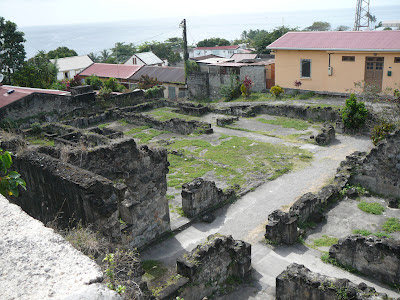No, not a tale of whales, but two tales of volcanoes and the destruction they cause. The Eastern Caribbean islands where we've been living this past year are mostly volcanic. They have the same MO as we sail by: lush green hills crowned by a perfect volcano crater, topped with fluffy white clouds, quiet and peaceful. We got a chance to see the other side of the mountain, so to speak, the destructive, uncaring, violent side.
Mount Pelee, above, stands above the town of St Pierre on the NW corner of Martinique. It erupted in 1902, sending a "fireball of superheated gas that flowed down over the city... All that remained were smoking ruins". Almost 30,000 people burned to death, leaving (depending on the reports) only 2 or 3 survivors. The new city of St Pierre wasn't rebuilt until 1923 and is built around and on the old ruins. The ruins are visible throughout the town, old walls that are now part of new structures.
 |
| The former entrance to the Theatre. |
 |
| The ruins of the Police Station/Prison where Louis Cyparis survived the eruption . |
 |
| Louis Cyparis, he had an interesting life, go to here for the story. |
 |
| Statue and inscription at the entrance of the old Theatre. |
Volcano #2 is the island country of Montserrat.
 |
| Soufriere, from outside the 2 mile maritime exclusion zone, showing the ash flows. Plymouth was on the far left. |
The Soufriere eruption is a much more recent event, so with more modern seismic equipment, only 19 people died when it blew in 1995, burying the capitol city of Plymouth. It continued to spew ash, making living conditions very difficult, and during the next few years nearly 2/3 of the population left the country.
 |
| Plymouth houses surrounded by the ash flow. |
 |
| The third story of a home buried by ash. |
 |
| The ash continues to fall, bird tracks on a stair rail. |
 |
| I don't know if it was the ash in the air or just the time of year, but the sunsets were spectacular. |


No comments:
Post a Comment